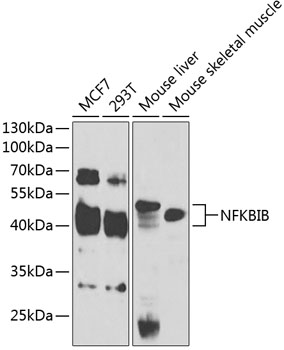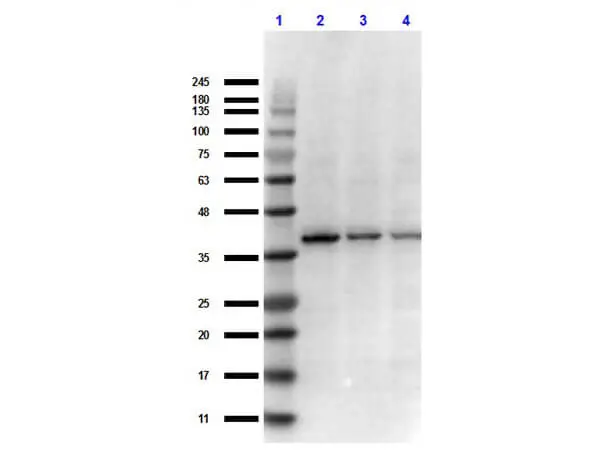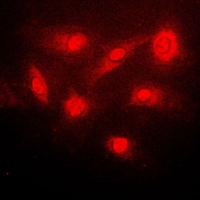![IHC-P analysis of human stomach tissue using GTX34098 IKB beta antibody [1F3]. Negative control (the lower left coner) was secondary antibody only. Antigen retrieval : Sodium citrate pH6.0 was used for antibody retrieval (>98oC, 20min) Dilution : 1:200 IHC-P analysis of human stomach tissue using GTX34098 IKB beta antibody [1F3]. Negative control (the lower left coner) was secondary antibody only. Antigen retrieval : Sodium citrate pH6.0 was used for antibody retrieval (>98oC, 20min) Dilution : 1:200](https://www.genetex.com/upload/website/prouct_img/normal/GTX34098/GTX34098_20200622_IHC-P_040_w_23060801_913.webp)
IHC-P analysis of human stomach tissue using GTX34098 IKB beta antibody [1F3]. Negative control (the lower left coner) was secondary antibody only. Antigen retrieval : Sodium citrate pH6.0 was used for antibody retrieval (>98oC, 20min) Dilution : 1:200
IKB beta antibody [1F3]
GTX34098
ApplicationsImmunoHistoChemistry, ImmunoHistoChemistry Paraffin
Product group Antibodies
TargetNFKBIB
Overview
- SupplierGeneTex
- Product NameIKB beta antibody [1F3]
- Delivery Days Customer9
- Application Supplier NoteIHC-P: 1:100-1:200. *Optimal dilutions/concentrations should be determined by the researcher.Not tested in other applications.
- ApplicationsImmunoHistoChemistry, ImmunoHistoChemistry Paraffin
- CertificationResearch Use Only
- ClonalityMonoclonal
- Clone ID1F3
- Concentration1 mg/ml
- ConjugateUnconjugated
- Gene ID4793
- Target nameNFKBIB
- Target descriptionNFKB inhibitor beta
- Target synonymsIKBB, TRIP9, NF-kappa-B inhibitor beta, I-kappa-B-beta, NF-kappa-BIB, TR-interacting protein 9, TRIP-9, ikB-B, ikB-beta, ikappaBbeta, nuclear factor of kappa light polypeptide gene enhancer in B-cells inhibitor, beta, thyroid receptor-interacting protein 9
- HostMouse
- IsotypeIgG1
- Protein IDQ15653
- Protein NameNF-kappa-B inhibitor beta
- Scientific DescriptionThe protein encoded by this gene belongs to the NF-kappa-B inhibitor family, which inhibit NF-kappa-B by complexing with, and trapping it in the cytoplasm. Phosphorylation of serine residues on these proteins by kinases marks them for destruction via the ubiquitination pathway, thereby allowing activation of the NF-kappa-B, which translocates to the nucleus to function as a transcription factor. Alternatively spliced transcript variants have been found for this gene.[provided by RefSeq, Jul 2011]
- Storage Instruction-20°C or -80°C,2°C to 8°C
- UNSPSC12352203

![IHC-P analysis of human liver cancer tissue using GTX34098 IKB beta antibody [1F3]. Negative control (the lower left coner) was secondary antibody only. Antigen retrieval : Sodium citrate pH6.0 was used for antibody retrieval (>98oC, 20min) Dilution : 1:200 IHC-P analysis of human liver cancer tissue using GTX34098 IKB beta antibody [1F3]. Negative control (the lower left coner) was secondary antibody only. Antigen retrieval : Sodium citrate pH6.0 was used for antibody retrieval (>98oC, 20min) Dilution : 1:200](https://www.genetex.com/upload/website/prouct_img/normal/GTX34098/GTX34098_20200622_IHC-P_071_w_23060801_140.webp)
![IHC-P analysis of rat kidney tissue using GTX34098 IKB beta antibody [1F3]. Negative control (the lower left coner) was secondary antibody only. Antigen retrieval : Sodium citrate pH6.0 was used for antibody retrieval (>98oC, 20min) Dilution : 1:200 IHC-P analysis of rat kidney tissue using GTX34098 IKB beta antibody [1F3]. Negative control (the lower left coner) was secondary antibody only. Antigen retrieval : Sodium citrate pH6.0 was used for antibody retrieval (>98oC, 20min) Dilution : 1:200](https://www.genetex.com/upload/website/prouct_img/normal/GTX34098/GTX34098_20200622_IHC-P_221_w_23060801_903.webp)
![IHC-P analysis of rat spleen tissue using GTX34098 IKB beta antibody [1F3]. Negative control (the lower left coner) was secondary antibody only. Antigen retrieval : Sodium citrate pH6.0 was used for antibody retrieval (>98oC, 20min) Dilution : 1:200 IHC-P analysis of rat spleen tissue using GTX34098 IKB beta antibody [1F3]. Negative control (the lower left coner) was secondary antibody only. Antigen retrieval : Sodium citrate pH6.0 was used for antibody retrieval (>98oC, 20min) Dilution : 1:200](https://www.genetex.com/upload/website/prouct_img/normal/GTX34098/GTX34098_20200622_IHC-P_244_w_23060801_711.webp)
![IHC-P analysis of human kidney tissue using GTX34098 IKB beta antibody [1F3]. Dilution : 1:200 IHC-P analysis of human kidney tissue using GTX34098 IKB beta antibody [1F3]. Dilution : 1:200](https://www.genetex.com/upload/website/prouct_img/normal/GTX34098/GTX34098_20200622_IHC-P_316_w_23060801_446.webp)
![IHC-P analysis of human lung carcinoma tissue using GTX34098 IKB beta antibody [1F3]. Dilution : 1:200 IHC-P analysis of human lung carcinoma tissue using GTX34098 IKB beta antibody [1F3]. Dilution : 1:200](https://www.genetex.com/upload/website/prouct_img/normal/GTX34098/GTX34098_20200622_IHC-P_339_w_23060801_488.webp)



![WB analysis of Jurkat cell lysate using GTX82797 IKB beta antibody [7B4].](https://www.genetex.com/upload/website/prouct_img/normal/GTX82797/GTX82797_20170912_WB_w_23061322_464.webp)

